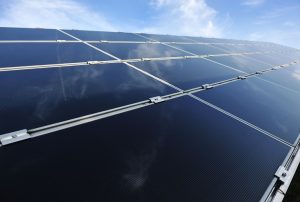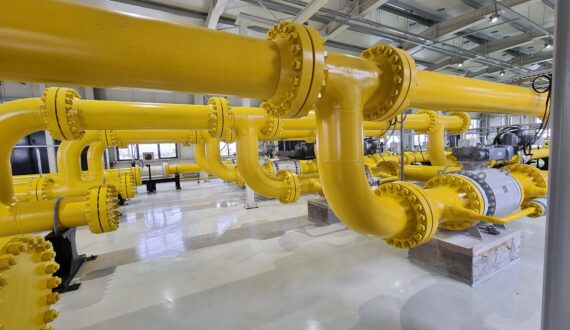The series of articles on renewable energy continues with an article on the efficiency of solar cells and existing types of solar cells. These articles aim to shed light on how to obtain clean energy and to bring as much information as possible to the public, so that we are aware of the importance of switching to ways of obtaining energy through clean technologies and consuming as little resources as possible.
The efficiency of solar cells
The efficiency of the solar panel refers to how much electricity we get from the solar energy that falls on the panel.
The surface of photovoltaic cells is usually very small and the current generated by a single cell is small. Therefore, several such photovoltaic cells are connected to each other, in series or in parallel, so that they can produce enough current to be used in practice. These cells are integrated into the panels to increase their mechanical strength and weather resistance.
The electrical efficiency of a photovoltaic cell is a physical property that represents how much electricity a cell can produce for a given solar radiation. The basic expression for the maximum efficiency of a photovoltaic cell is given by the ratio between the output power and the incident solar energy (radiation flux zone). Efficiency is measured under ideal laboratory conditions and represents the maximum achievable efficiency of the cell or photovoltaic module.
The real efficiency of a solar panel depends on several factors: the material from which it is produced, the type of mounting chosen (fixed or mobile), the angle from which the light falls on the panel, partial shading, aging of the panels, temperature.
To better understand how a solar cell works and what its efficiency means, you need to know that there are several types of materials from which they can be made, each with different characteristics.
Types of solar cells
The best known types of solar cells are: CIS (Cooper Indium Diselenide), CIGS, CdTe (Cadmium Telluride), monocrystalline, polycrystalline, amorphous and thin film.
Out of this crowd, the most efficient monocrystalline and polycrystalline solar cells have stood out, but we are talking about the commercial cells on the market at the moment.
The most widely used are silicon-based solar cells.
Silicon solar cells
The most widely used material for the manufacture of semiconductor solar cells is silicon .
Silicon is the almost ideal material. It is inexpensive, can be produced in a single crystal at a high degree of purity, and can be contaminated in semiconductor type “n” or “p”. By simple oxidation, thin insulating layers can be created.
Crystalline silicon-based solar cells require a layer thickness of at least 100 µm or more to be able to absorb sunlight efficiently. In direct semiconductor thin-film cells such as GaAs or even silicon with a strongly disturbed crystalline structure, 10 µm are sufficient. (source: Wikipedia.org)
Depending on the crystalline state, the following types of silicon differ:
Monocrystalline
The cells result from silicon plates in a crystal (Wafer). These crystals are the basic material for the semiconductor industry and are quite expensive.
Polycrystalline
The cells are made of plates that contain areas of crystals with different orientations. They can be manufactured, for example, by the casting process, they are cheaper and as such the most widespread in the production of photovoltaic devices. They are often called polycrystalline solar cells.
Amorphous
Solar cells consist of a thin layer of amorphous silicon (without crystallization) and are therefore called thin-layer cells. They are very cheap, but have a low efficiency in the spectrum of sunlight, yet they have advantages in low light. That is why it is used in pocket computers and watches.
Microcrystalline
These are thin-film cells with a microcrystalline structure. They have a better yield than amorphous cells and do not have a layer as thick as polycrystalline ones. It is partially used in the manufacture of photovoltaic panels, but they are not so widespread.
Tandem solar cells are overlapping layers of solar cells, usually a combination of polycrystalline and amorphous layers. The layers are made of different materials and thus tuned to different wavelength ranges of light. By using a wider spectrum of sunlight, these cells have a higher efficiency than simple solar cells. They are partially used in the manufacture of solar panels but are relatively expensive. An appreciable reduction will be obtained by using in combination with lens systems, the so-called concentration systems.
 Aging of solar cells
Aging of solar cells
Over time, the operating parameters of the semiconductor elements of solar cells change. In this case, the yield decreases over their lifetime.
Over a period of 20 years, under terrestrial use, the yield decreases by about 10%, while in space this percentage is reached in a much shorter time due to much stronger radiation fields.
Often, the loss of efficiency occurs due to causes independent of solar cells, such as soiling of the surfaces of the protective glass of the modules, mold starting from the module frame, shading of the modules by the surrounding vegetation grown in the meantime, yellowing of polymers contact between cell and glass.
The yield of crystalline solar cells
At current solar cells the yield is about 12 – 17%. Usually, the manufacturer gives a guarantee of efficiency of 80 – 85% (at peak power) after 20 years. This means very small losses over a long period of time which justifies the use of photovoltaic systems.
The defects from recombination are responsable for the actual aging of the solar cells, which reduces the life of the charge carriers by about 10% compared to the initial value.
The yield of amorphous solar cells
These cells reach an advanced degree of aging of up to 25% in the first year of operation, therefore for this type of solar panels in the technical characteristics of the accompanying documents is not given the power achieved at the manufacture but the power after the aging process. As a result, these types of panels have better purchasing characteristics than those in documents. Aging occurs under the action of light and is the result of the so-called Staebler-Wronski effect (SWE). After about 1,000 hours of sun exposure, the amorphous silicon cells reach a stable degree of saturation.
Technical characteristics of solar cells
Technical parameters of solar cells are given for Standard Test Conditions (STC): light intensity of 1000 W / m 2 in the panel area, solar cell temperature constant 25 ° C, global light spectrum AM 1.5; DIN EN 61215, IEC 1215, DIN EN 60904, IEC 904.
The characteristics of a solar cell are: idle voltage, short-circuit current, voltage at the optimum operating point, current at the maximum power point, estimated maximum power, fill factor, power change coefficient with cell temperature, solar cell efficiency η at an illuminated surface A and light intensity P.
The efficiency is the ratio between the power delivered by the panel and the power contained in the total incident light. Semiconductors with a stable restricted area use only part of the sunlight. The maximum theoretical efficiency that can be achieved in this case is 33%, while the maximum theoretical efficiency for multi-band systems that react to all wavelengths of sunlight is 85%.
| Material | Efficiency(AM1,5) | Lifetime | Costs |
| Amorphous silicon | 5-10% | < 20 years | |
| Polycrystalline silicon | 10-15% | 25-30 years | 5 EUR/W |
| Monocrystalline silicon | 15-20% | 25-30 years | 10 EUR/W |
| Gallium arsenide (monolayer) | 15-20% | ||
| Gallium arsenide (two layers) | 20% | ||
| Gallium arsenide (three layers) | 25% (30% la AM0) | >20 years | 20-100 EUR/W |
Table 1 – Yield and service life depending on the material of the photovoltaic cell Source: Wikipedia.org
The efficiency of commercial solar cells is about 20%, and the modules built with them reach a efficiency of about 17%.
The most efficient solar cells
The most efficient type of solar cell to date is a 46.0% multi-junction concentrator solar cell produced by Fraunhofer ISE in December 2014.
The highest efficiency obtained without concentration includes a material from Sharp Corporation at 35.8% using a triple junction manufacturing technology in 2009, and Boeing Spectrolab (40.7% using a three-layer design).
Specialized gallium arsenide (GaAs), made in the USA, Alta Devices, produces commercial cells with an efficiency of 26%, claiming to have the only “most efficient solar” cell in the world dedicated to flexible and light applications.
For Silicon solar cells, the American company SunPower remains the leader with a certified module efficiency of 22.8%, well above the market average of 15-18%.
There is a continuous effort to increase the conversion efficiency of photovoltaic cells and modules, mainly for a competitive advantage. There are several groups of materials that are being developed. Devices with ultra-high efficiency (η & gt; 30%) are made by using GaAs and GaInP2 semiconductors with multifunctional tandem cells. High quality, single crystal materials are used to obtain high efficiency cells at low cost (η & gt; 20%).
So far, the highest reported power conversion efficiency ranges from 6.7% to 8.94% for small molecule, 8.4% –10.6% for polymeric OPVs and 7% to 21% for OPVs perovskite. It is estimated that OPVs will play a major role in the photovoltaic market. Recent improvements have increased efficiency and reduced costs, while remaining benign and renewable for the environment.
Several companies have begun to incorporate power optimizers into PV modules called smart modules. These modules perform maximum power point tracking (MPPT) for each module, measure performance data for monitoring, and provide additional safety features. Such modules can also compensate for shading effects, in which a shadow that falls on a section of a module causes the electrical output of one or more rows of cells in the module to decrease.
One of the major causes of decreased cell performance is overheating. The efficiency of a solar cell decreases by about 0.5% for each temperature rise by 1 degree Celsius. This means that a 100 degree increase in surface temperature could reduce the efficiency of a solar cell by about half. Self-cooling solar cells are a solution to this problem. Instead of using energy to cool the surface, pyramids and cone shapes can be made of silica and attached to the surface of a solar panel. Thus, visible light can reach the solar cells, but it reflects infrared rays (which carry heat).
Sursă: Wikipedia.org








